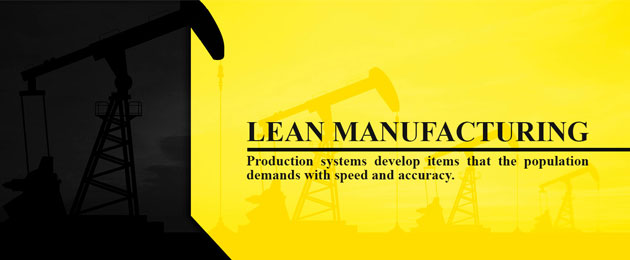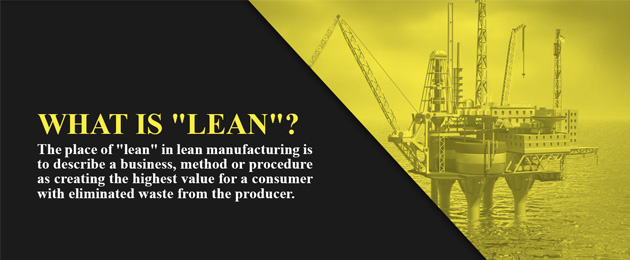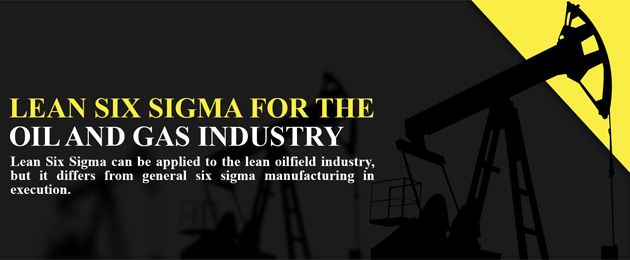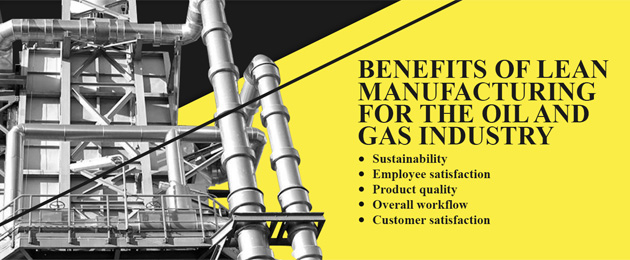Lean Manufacturing Processes in the Oil and Gas Industry: What You Need to Know

Lean Manufacturing
Production systems develop items that the population demands with speed and accuracy. However, the way items are formed and placed in front of consumers is an involved function that has not always been efficient or pleased customers to the greatest extent possible. Lean manufacturing was developed when time and materials were not being used to their highest potential.
The basic concept of lean manufacturing has to do with how an entity can cut out unnecessary steps or hindrances to achieve the best selection for all customers. The oil and gas industry has begun to adopt lean principles in order to effectively compete using an increasingly called-for material with a changing market cost.
What Is "Lean"?
The place of "lean" in lean manufacturing is to describe a business, method or procedure as creating the highest value for a consumer with eliminated waste from the producer. Lean can be used as a shortened version of "lean manufacturing" or as a description of any system that runs with exact productivity to deliver prime quality and zero waste.
inv

With lean processes, any source that expends useless energy, material or capital is shaved off until the waste level vanishes. The waste per unit of production must be instituted company-wide, and the flow of production should be stretched to an overarching angle.
The main objective of lean manufacturing is to save employees extra effort and additional time spent on projects. Workers will then use their time to the full capacity for the essential tasks rather than laboring long hours over convoluted assignments.
Lean Manufacturing History & Beginnings
The Industrial Revolution is largely viewed as taking place in the 18th and 19th centuries. While it started in Britain in the late 1700s, it quickly spread into other areas of Europe and America as society transitioned from agrarian and rural to industrial and urban.
Over the next hundred years, inventors and engineers developed revolutionary products. Many of these products still impact us today:
- the coffee pot (1806)
- Robert Fulton's steamboat (1807)
- the electromagnetic motor (1830)
- the first power tools (1837)su
- the first oil well (1857)
- the first oil pipeline (1864)
However, in the late 1890s, industrial engineers began considering questions about the combination of manufacturing processes and mass production. This is when the birth of lean manufacturing occurred.
Who Invented Lean Manufacturing?
While the concepts of lean manufacturing are much different today than in the early 1900s, there is no doubt that early industrial engineers invented lean manufacturing. Many consider the most influential of these engineers to be Henry Ford, founder of the Ford Motor Company.
At the time of its founding in 1903, the Ford Motor Company was just 1 of 88 car companies in the United States. While all of the other companies viewed automobiles as luxury items, Henry Ford had a different perspective. Ford’s true stroke of genius was in realizing that cars could be produced more efficiently, making them more affordable for the general public.
Ford implemented a system in which the critical elements of manufacturing — including the people, machines, tooling and products — were arranged in a continuous assembly line. This system enabled the Ford Motor Company to deliver over fifteen million Model T cars during a 19-year production run. Due to these accomplishments, many people consider Henry Ford the first to implement lean manufacturing principles.
Overcoming Weaknesses and Establishing Lean Manufacturing
Despite all his successes, Ford’s system also had several notable weaknesses. For one, the system was designed to produce a single end product with no variability. As a result, the Ford manufacturing system did not easily allow for the ability to change models or customize a car with options as simple as color. Alfred Sloan of General Motors recognized this weakness and made modifications to Ford’s system to allow for larger scale manufacturing and variety.
The Toyota Motor Company also studied the Ford production methods and identified areas of improvement. Toyota combined Ford’s production methods with the practices of Statistical Quality Control to develop the Just In Time production system, later called the Toyota Production System (TPS).
In particular, Toyota began looking at workers as more than just laborers and instead viewed them as integral parts of the process. Toyota began to incorporate aspects of team development and cellular manufacturing — arranging workstations and equipment in sequence to ensure a smooth flow through the production process. Making these changes allowed Toyota to start producing in small quantities and with much more variation.
The evolution of automobile production processes was chronicled in James Womack’s 1990 book “The Machine That Changed the World.” With little idea of his impact at the time, Womack christened these processes into a single term: “lean manufacturing.”
The Evolution of Lean Manufacturing Principles
From 1990 to today, the concepts of lean manufacturing have continued to develop. Specifically, lean manufacturing principles are those that seek to minimize waste during the manufacturing process. More broadly, lean manufacturing now encompasses any technique or process that enables a process to run more efficiently.
Much like the original statistical quality processes that formed the foundation for the Toyota Production System, today’s lean manufacturing processes often integrate current quality control principles such as Six Sigma. For this reason, eliminating waste and improving quality usually go hand-in-hand in lean manufacturing best practices.
As lean concepts continue to develop, lean tools and techniques are being extended beyond manufacturing. Managers and corporate leaders are applying lean concepts in healthcare, retail, logistics and distribution, construction and many other industries — including the government.
Lean tools and techniques take on many different forms, and they are partially dependent on the overall goals of the organization. While some organizations focus solely on reducing the cost of production and increasing profit, others take a more customer-centric approach.
In the latter case, lean manufacturing best practices are guided by the overarching objective that improvements are made for the sake of the customer. In a customer-centric lean system, any production step or end product that does not meet customer demand or specifications is considered waste. This notion of customer-based waste is considered to be the foundation on which the eight kinds of waste are built. Waste reduction continuously refers back to delivering quality products to the customer without complicating and impeding the regular flow of production and transaction. Let's take a look at the eight categories of waste.
Wastes in Lean Manufacturing
The primary goal of lean manufacturing is the elimination of waste. Waste can be defined in different ways and at different stages of the production process. In addition to customer-based waste, lean tools and techniques are typically used to eliminate eight types of waste. These eight types can be represented using the acronym D.O.W.N.T.I.M.E.
1. Defects
The waste associated with defects, including any extra efforts involved in finding and fixing product defects, is a direct example of labor, time and material misuse affecting the commodity and the consumer's reception of it. Disposing of faulty products dispenses the time involved in the first attempt and the follow-up reparation. Expenses for production, repairs and delivery take capital away from your operation.
2. Overproduction
When a company is generating more product than necessary, it shows that the customer needs are not being considered and factored into the specifications for optimum market value. The demands of the consumer are a driving force in lean manufacturing, so gauge the quantity of production on economic value.
3. Waiting
Any action or inaction that causes a delay in the production process can lead to fewer products for customers. This situation can create dissatisfied customers who expect the commodity to be made available to them and delivered promptly. Delays in production limit an entity's flow and diminish revenue that could have come from a steady exchange of goods. Minimizing the wait time in between processes will reduce overall wasted time and please the target market.
4. Not Utilizing Talent
Failing to recognize the proficiency, creativity and expertise of employees is the equivalent of neglecting valuable material resources. Workers who are properly trained and challenged enrich a process' productivity. Accepting feedback from employees is also a practical way to enhance a lean system. Improved delegation can segment tasks without roles overlapping or functions repeating.
5. Transportation
Transportation relates to the workflow and processes of a manufacturing facility. Any movement of products not actually required to perform the production process normally occurs when a commodity travels to several areas of a facility for simple tasks that can be combined.
The transportation of a product, depending on loading and unloading, may take up a significant period of time compared to the production time. Simplifying steps and ensuring less handling of the commodity improves transportation uses. Assign clear tasks that follow a smooth system to avoid extraneous handoffs of the commodity to distant regions of the facility.
6. Inventory
Closely tied to overproduction, inventory waste is when time, power and space must be invested in holding a commodity. Any component, subassembly, intermediate work or finished product that impedes the overall process detracts from moving desired goods at the right speed. The inventory may be in demand in this situation, but the buying rate doesn't match the production rate. Supplier issues, monitoring problems and customer disconnect can each be a reason inventory efforts harm a manufacturer.
7. Motion
The motion of people and equipment that aren't necessary in the production process requires restructuring workstations to eliminate congestion in workstation efficiency. Employees who don't have regular access to machines, have shared equipment or have isolated positions from routinely used items necessary in production are misusing motion. Using the movements of employees in the best way expedites the operation.
8. Excess Processing
The term "excess processing" entails recurring procedures that halt or slow down an operation. Wasteful steps in a production process result from poor tool, system or product design. Redundant documentation or avoidable meetings that do not improve communication or standards for advantageous commodities only increase expenses and decrease available time.
How a company chooses to address these wastes is what defines their own lean manufacturing process. Despite variations from one company to another, lean manufacturing applications in all industries are guided by nine core principles.
What Is Six Sigma?
Lean Six Sigma was formed by Motorola in 1986 when they shifted their management to focus on ways to analyze data and meet the highest standards possible. This mathematical objective is used in several lean systems to monitor the consistency and nature of their products.
Lean Six Sigma applies the strategy of reducing waste to protecting commodities against defects and limiting variation between products. It also solves problems that arise during production based on collected data and a mathematical solution technique. When Six Sigma was first established, the defect amount of parts per million (PPM) was 3.4 defects. Keeping this level low enhances customer experience and the reputability and quality of commodities coming from a company.
In the statistical sense, "sigma" is the standard deviation in this process. One specification limit in a company's production procedure has six standard deviations between the mean of the procedure and the consumer standard cap.

Lean Six Sigma Principles
Six Sigma operates in a cyclical way when identifying issues that can reduce quality and refinement. This data-focused approach includes participation from employees and keen observational skills. There are five Lean Six Sigma principles, or phases:
1. Define
The customer experience and satisfaction is a primary aim of Six Sigma. Consider the market and the reaction of the customer to different specifications. Define customer preferences and standards in order to identify further changes and improve the system.
2. Measure
To consistently isolate problems and solve them, collect data from the processes. Measuring is essential to determining quality and efficiency, and it doesn't detract from lean manufacturing but rather ensures the appropriate condition of the commodity.
3. Analyze
Once data has been gathered, review the information to establish the weak points of the operation. Analyze which segments are producing defects or hindrances to the production process.
4. Improve
Act on the evidence-based analysis made, and enhance the manufacturing flow by altering the faulty points. Improvements in employees, machinery, transportation and more will preserve capital and progress the system toward its goal.
5. Control
Now that Six Sigma principles are in place, continue to control the process by eliminating issues and fixing variations. Supervise the process in this cyclical method to manage the factors that produce variation.
An alternative set of phases — define, measure, analyze, design and verify — is used when working on a completely new or undeveloped project. For the purposes of general manufacturing, these five principles can significantly increase consistency and trim defective processes form a manufacturing system.
Lean Six Sigma for the Oil and Gas Industry
Lean Six Sigma can be applied to the lean oilfield industry, but it differs from general six sigma manufacturing in execution. Lean Six Sigma is most successful in manufacturing oil when three areas are emphasized— service quality drilling operations, supply chain and customer satisfaction.
9 Lean Manufacturing Principles
Lean manufacturing is not a specific set of steps to take or rules to follow. Instead, lean manufacturing provides a framework — your company can develop and customize your own production systems in order to minimize the seven sources of waste.
Nine guiding principles are often used to evaluate the potential applications of lean manufacturing and how they positively impact a production process. Used individually or collectively, the following principles help to address the sources of waste:
1. Continuous flow
strives to eliminate waste of movement and inventory by connecting sub-processes and ensuring a smooth production flow. The inventory enters as needed and leaves the line when completed.
2. Lean machines/simplicity
focuses on minimizing the design of machines and assembly workspaces in order to reduce space allocation and simplify the role of each machine or worker. This helps to eliminate waste of movement, inventory, motion and over-processing.
3. Workplace organization
places an emphasis on improving the organizational aspects of a worker’s station including accessibility to tools and information. Workplace organization is primarily focused on minimizing waste from unnecessary motion and waiting, but also has the benefit of improving quality and reducing defect waste.
4. Parts presentation
addresses the delivery and lean manufacturing of inventory to workstations as needed, reducing waste associated with transport, inventory, motion and waiting.
5. Reconfigurability
addresses the need to reconfigure a workstation quickly and efficiently to meet changing demands or to alleviate issues in the production process. The primary benefit of reconfigurability is the reduction of downtime and waste.
6. Product quality
covers any quality assurance step or process designed to reduce defects in both the production process and the final product.
7. Maintainability
focuses on keeping the entire production system and individual workstations operating smoothly and efficiently, minimizing downtime.
8. Ease of Access
see below
9. Ergonomics
these two processes work together in the design of the production system to place parts and tools where needed, minimizing motion and downtime. They also work together to ensure the worker is operating in an efficient and safe workplace.
With these guiding principles in mind, let’s take a look at how they could impact oil and gas industry trends.
The Role of Lean Manufacturing in the Oil and Gas Industry
Ever since the first oil well in 1857 and the first oil pipeline in 1864, the oil and gas industry has not only embraced innovation but has often led the way. Rapid technological advances have enabled both the discovery and extraction of oil and gas in difficult environments — from the deserts of the Middle East, to deep water oil fields around the globe and finally to the harsh Arctic region.
With the recent focus on energy independence in the United States, as well as the added scrutiny that comes with it, lean manufacturing in the oil and gas industry is quickly becoming a necessity.
Oil and Gas Industry Overview
Oil and natural gas are naturally occurring substances in the Earth’s crust — the results of centuries of decay of plants and animals trapped in the layers of the Earth over time. Because oil and gas are less dense than water, they gradually work their way through porous rocks and towards the Earth’s surface. They eventually collect into reservoirs.
Once these reservoirs are found, a hole must be bored through the Earth’s upper crust and into the reservoir, allowing the extraction of the oil or gas. This role of discovery and drilling is completed by the exploration and production (E&P) segment of the oil and gas industry. The drilling companies are supported by a large group of oil services and equipment providers.
Together, all of the companies that support the E&P segment play a critical role in providing oil in gas to the world in a safe and efficient manner — with minimal waste and impact on the environment.
Drilling and Its Effects on the Environment
The E&P process includes many different activities:
- the construction of access roads and support facilities
- ground clearing and grading
- the drilling process
- waste management
- the downstream infrastructure necessary to get the extracted oil and gas into the energy system
All of these activities have the potential to impact the environment. As with any construction project, steps must be taken to avoid any adverse impact to both the natural environment and the surrounding communities.
In particular, processes should be followed to minimize ground erosion and runoff, and control dust and other airborne contaminates. It’s also important to minimize noise from operations and reduce the interference with the natural habitat including both plants and animals.

Types of Drilling
Drilling practices in the oil and gas industry start with measuring the area, determining the drill bit and evaluating the strength of the drill motor for the depth of the job. Once these factors are established, the oil or gas well area should also be reviewed for the kind of rock present and the tectonic plates around the reservoir.
Safety and machinery materials are essential in lean manufacturing to conserve time, effort and capital. Drilling includes the best practices of lean manufacturing techniques. Vertical, horizontal and offshore drilling continue to be the leading drilling methods, but deviated and multilateral drilling are also practiced.
Vertical
Since the early days of the oil and gas industry, vertical drilling was the dominant method for drilling a well. In vertical drilling, a drill head is attached to the end of a steel drill bit and additional drilling shafts are gradually added and fed down the wellbore. A rotating drilling rig is used to drive the full assembly from the surface.
Vertical drilling has become less popular and less productive, and in 2016, approximately 670,000 of the 977,000 producing wells were not vertical but horizontally drilled — and hydraulically fractured. Vertical drilling remains a cheaper option, but it often does not produce the optimum amount of gas and oil.
Hydraulic fracturing is the practice of pushing fluids through a wellbore to split the surrounding depths into fractures that produce more gas and oil. The fluid that's sent through the wellbore includes water and additional materials that keep the fractures open once fractured. An increase in natural resources is induced through this added measure. Horizontal drilling and hydraulic fracturing have opened more opportunities for offshore drilling, especially in the United States, steering the industry away from vertical drilling.
Horizontal
While vertical drilling is the simplest of the drilling methods, its simplicity also leads to a higher rate of dry wells — those that don’t successfully hit the reservoir. Directional drilling began in the 1950s, when John Zublin and H. John Eastman attempted to use existing wells to drill off from. Within the last couple decades, the development of directional and horizontal drilling techniques has enabled E&P companies to dramatically increase their success rate. As the name implies, directional drilling enables the operator to begin with a vertical well and then change directions to either an angled or horizontal bore in order to increase the chances of hitting the reservoir.
Deviation is a common horizontal drilling process in which a drill string and steering head create a deviation off a vertical well to transition to a horizontal direction. Deviating into a horizontal well brings more access to plentiful zones, fracturing and new structural options.
When wells gradually become less viable sources for oil and gas, they're termed marginal wells. Although they still have a limited amount of emissions, the wells are not profitable anymore. The cumulative number of marginal wells in 2016 added up to 10 percent of the United States' oil production in 2016. These smaller sources may not give off as much oil and gas as others, but they still contribute to the production of this industry over time.sus
Offshore
Both vertical and directional drilling techniques can be applied to offshore drilling operations. The primary difference with offshore drilling is the fact that the drilling rig is located on the surface of the water rather than on dry land. Offshore rigs can either be fixed rigs — mounted on to pilings or columns connected to the ocean floor — or floating rigs. Due to the uncertainty and occasional harshness of the ocean environment, offshore drilling adds a noticeable level of complexity and risk to the drilling operation.
Extended reach drilling or multilateral drilling is a directional drilling method for offshore locations where one point gives access to the entire reservoir. The main well acts as a base for branches of alternate wells. This form of horizontal directional drilling can be better for the environment through the diminished disturbance of natural habitats on dry land operations, although as previously stated, the offshore equivalents have more complex results.
Extraction Methods
Once the exploratory phase is over, and a wellbore has been successfully drilled to the reservoir, the process of extraction begins. The easiest extraction method occurs naturally. It takes advantage of the pressure in the well to drive the oil and gas to the surface. When the pressure is insufficient or dissipates over time, E&P companies may employ pumps to artificially lift the resources to the surface.
When pumping doesn’t work, other techniques may be applied. These techniques include pumping water down the well to force the oil up or using chemicals or pressurized fluids to fracture the rock formations. In particular, hydraulic fracturing has become the enabling technology behind the U.S. shale gas boom.
Applications of Lean Manufacturing to the Oil and Gas Industry
Due to the specialized nature of the oil and gas industry and the uniqueness of each individual drilling project, many suppliers develop engineer-to-order (ETO) products. E&P service providers often design products to unique specifications, with long delivery times and extended maintenance responsibilities for the life of the product. The non-repetitive nature of these services appears contrary to the fundamental objectives of lean manufacturing, but that’s not necessarily the case.
The oil and gas industry — and the E&P segment in particular — is ultimately a process involving a collection of many other processes that come together to take an E&P project from initial exploration to extraction. Every construction process, every ETO product and every E&P service has the potential to implement a lean manufacturing process.
E&P projects can benefit from the Lean and Six Sigma systems and stand up to scrutiny. Many oil and gas manufacturers have embraced lean manufacturing, and further involvement in the industry promotes customer satisfaction and quality practices and drilling operations.
These two lean manufacturing byproducts often complement the EPA objectives of environmental management and pollution prevention.

Benefits of Lean Manufacturing for the Oil and Gas Industry
The oil and gas industry has increased demands for environmentally friendly practices, which means change is inevitable for manufacturers. Automated equipment in the oil and gas industry is easing the process of lean manufacturing and Six Sigma, as error and waste have dwindled. Implementing lean manufacturing as a total system renovation will cause success and an increase in capital. Many gas and oil manufacturers have taken on this system and seen the benefits. Successful lean manufacturing examples include Exxon Mobil and Chevron.
Sustainability:
Sustainability, not only in environmental terms but also in a business sense, is a benefit of lean manufacturing. Reducing costs and waste and enhancing customer relations makes for a more concrete projected future. The model ensures long-term benefits and durability.
Employee satisfaction:
Customers are not the only ones left pleased by high-quality commodities either — employees and the company operation as a whole will improve due to clear expectations, utilized skills and productive projects. Effective workstations and reduced overlap in roles will enhance management and morale. Employee training for lean manufacturing prepares employees for the transition into the lean system and facilitates creative and productive team practices.
Product quality:
Pairing Six Sigma with lean principles also ensures reduced variation in the commodity and a higher-caliber product to extend to customers. Quality production generates further revenue and customer satisfaction. Lean principles enhance the production process and the end product for an overall lucrative and streamlined process.
Overall workflow:
Responses to market demand and customer feedback will reduce any idle inventory and help lead time. Overproduction will be in check, and a steadier flow of commodities from production to consumers will develop. Space will be reduced by the restructuring of workrooms and by freeing up storage space formerly reserved for inventory.
Customer satisfaction:
Pleased customers receiving quality resources in a timely manner will report well about your company, causing an influx in positive feedback and reduced negative responses or requests for refunds. Lean manufacturers will grow in response to the saved time, effort and positive reputation the streamlined system produces.
Improving margins is a goal for many in the oil refining industry. Lean manufacturing in oil refineries can improve equipment startups, maintenance and checkouts. Setup, organization and maintenance procedures can be greatly reduced, even altering the turnaround cycle of the compressor valve, in one case, to 75 percent. Analysis methods at lean refining facilities can benefit from Six Sigma's data-centric nature.
Integrate Lean Manufacturing Tools Into Your System
If you’re an E&P company looking to start or continue integrating lean tools and techniques into your system, there’s no better place to start than with service providers that have already made the leap.
Global Elastomeric Products, Inc. has been supplying the oil services industry with high-quality rubber products for over 50 years. As an ISO 9001:2008 registered company, Global Elastomeric Products has the distinction of having a streamlined customer-to-manufacturing-to-customer process. We continue to invest in state-of-the-art injection machines, paint robotics, and manufacturing and enterprise resource planning systems to efficiently complete and deliver projects of any size.
For more information on how Global Elastomeric Products can help make your next project leaner, take a look at our specialized rubber products.
Contact us to discuss your project today.




